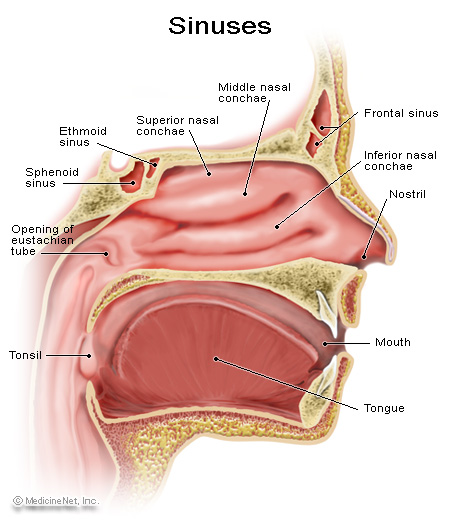
The sinuses are a connected system of hollow cavities in the skull. the largest sinus cavities are around an inch across; others are much smaller. the sinus cavities include:
• the maxillary sinuses (the largest), in the cheekbones.
• the frontal sinuses, in the low-center of the forehead.
• the ethmoid sinuses, between the eyes, at the nasal bridge.
• the sphenoid sinuses, in bones behind the nasal cavity.
The sinuses are lined with soft, pink tissue called mucosa. normally, the sinuses are empty except for a thin layer of mucus.
The inside of the nose has ridges called turbinates. normally these structures help humidify and filter air. the nose is divided in the center by a thin wall, called the septum. most of the sinuses drain into the nose through a small channel or drainage pathway called the middle meatus.
The purpose of the sinuses is unclear. One theory is that sinuses help humidify the air we breathe in; another is that they enhance our voices.
Sinus Conditions
- Acute sinusitis (sinus infection): Viruses or bacteria infect the sinus cavity, causing inflammation. Increased mucus production, nasal congestion, discomfort in the cheeks, forehead or around the eyes and headaches are common symptoms.
- Chronic sinusitis (or chronic rhinosinusitis): more than just a series of infections, chronic sinusitis is a persistent process of inflammation of the sinuses.
- Allergic rhinitis: Allergens like pollen, dust mites, or pet dander cause the defenses in the nose and sinuses to overreact. Mucus, nasal stuffiness, sneezing, and itching result.
- Deviated septum: if the septum that divides the nose deviates too far too one side, airflow can be obstructed.
- Turbinate hypertophy: the ridges on the nasal septum are enlarged, potentially obstructing airflow.
- Nasal polyps: Small growths called polyps sometimes grow in the nasal cavity, in response to inflammation. Asthma, chronic sinus infections, and allergic rhinitis can lead to nasal polyps.
Sinus Tests
- Physical examination: A doctor can look into the nose with a lighted viewer to see the turbinates, which may be swollen. She may press or tap on the face over the sinuses to check for pain.
- Computed tomography (CT scan): A CT scanner uses X-rays and a computer to create detailed images of the sinuses. CT scanning can help diagnose chronic sinusitis.
- Magnetic resonance imaging (MRI): Magnetic waves create highly detailed images of the sinuses. CT and MRI scans may be used together.
- Endoscopy (rhinoscopy): Using a flexible tube with a camera on its end, a doctor can examine the inside of the nose and sinuses.
- Sinus cultures: A mucus sample can be taken from inside the sinuses. This is done with a needle or during endoscopy.
- Skin Test for Allergies: Skin testing for various allergens can help determine if allergies are contributing to sinusitis.
- Sinus X-ray: A plain X-ray may show problems with the bones around the sinuses. A CT scan is superior to plain X-ray films.
Sinus Treatments
- Decongestants: Medications that cause blood vessels in the inner nasal tissue to constrict. as a result, there is less sinus congestion, mucus production and postnasal drip.
- Nasal steroid spray: Regular use of nasal steroids can reduce the symptoms of allergic rhinitis. these medications help relieve tissue swelling and help prevent the regrowth of nasal polyps after sinus surgery.
- Nasal saline spray: Salt water nasal spray breaks up dried mucus and helps to keep the nose moist.
- Nasal washes: rinse mucous from the nasal cavities and sinuses.
- Antihistamines: Oral histamine blockers (Benadryl, Claritin, Zyrtec, Allegra) can reduce the nasal and sinus symptoms from allergic rhinitis.
- Antibiotics: Anti-bacterial oral medicines may be needed to treat bacterial sinusitis.
- Sinus surgery: Surgery can improve or correct some sinus conditions. Usually surgery is used to remove growths or to open an obstruction.